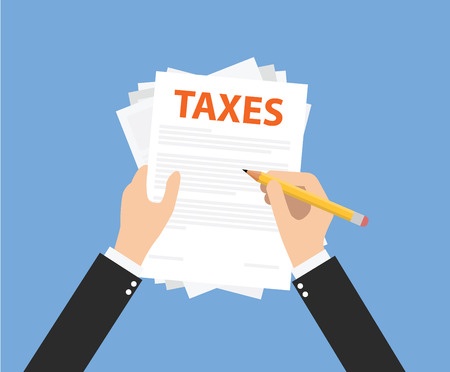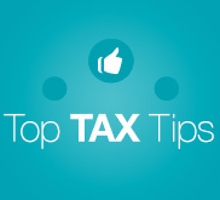SME Taxes You Should Know About
If you’re a small or medium-sized business (SME) owner there are a few taxes that you should know about in order to stay on top of what you owe.
Though not all of the below taxes will apply to your current tax situation, it’s helpful to be aware of all that may show up during the lifespan of your business to make sure you’re not taken by surprise. If you’re not yet working with an accountant you should consider hiring one immediately, as they can keep you up to date with your tax liabilities to ensure you’re always paying what you owe, when you owe it.
Income Tax
If you run your business as a sole trader the most important (and expensive) tax you should be aware of is income tax, which you’ll have to pay on your small business’s profits in the same way that an employed person pays income tax on their monthly earnings.
You pay income tax on your business’s profits over the personal allowance, which is currently set at £10,600 per year (2015-16) for those under seventy-five. If you run your business as a limited company you’ll be required to pay income tax on any salary or dividends you receive from your company over £10,600; including income from any other job or dividends from a second company.
National Insurance Contributions
National Insurance Contributions (NICs) are paid by SME owners and employed people alike, though the method of payment is different for those running their own business.
If you run your business as a sole trader you’re required to pay two different kinds of National Insurance; Class 2 and Class 4. The former is a flat weekly rate of £2.80, unless your business’s profits are under the newly-introduced Small Profits Threshold of £5,965 per year, in which case you’ll be exempt from Class 2 National Insurance. If your small business’s profits are £8,060 or more per year you’ll also be required to pay Class 4 National Insurance, which is set at 9 percent of your business’s profits up to £42,385, and just 2 percent thereafter (2015-16). From April 2016 Class 2 and Class 4 National Insurance Contributions are to be combined.
If you run your business as a limited company and you receive a salary of £8,060 or more per year then your business will have to pay Class 1 National Insurance on your salary.
Corporation Tax
If you run your business as a limited company you’ll have to pay Corporation Tax on all profits immediately, so long as you business hasn’t previously made a loss under which Corporation Tax can temporarily be offset against.
Corporation Tax is currently set at 20 percent (2015-16). It must be paid nine months and a day after the end of your business’s accounting period; this being something your accountant will make you aware of to maximise your cash flow.
Value Added Tax (VAT)
Value Added Tax (VAT) is payable by businesses operating as sole traders, partnerships, or limited companies if you make sales that should have VAT charged on them (known as the VAT taxable turnover) of more than £82,000 per year.
If you believe you’ll have a VAT taxable turnover of more than £82,000 in the next twelve months you or your accountant should register your business for VAT as soon as possible, to ensure any necessary payments can go through on time. VAT is charged at three rates; 20 percent (standard), 5 percent (reduced), and 0 percent (zero rate).
More Information from Experienced SME Accountants
To speak with a professional accountant to discuss the taxes you’re likely to come up against as an SME owner (including business rates, not discussed here) contact us today on 020 8780 2349 or get in touch with us via our contact page to arrange a complimentary, no obligation meeting.
Alternatively, take a look at our other tax related pieces to further increase your knowledge:
Homeworking Tax Relief for Your Employees
3 Ways to Make Tax Efficient Charitable Donations
For a wealth of information on most accountancy related issues, feel free to have a read of our blog too.
Tools for SME Accounting and Assessing Business Performance
Here at TaxAgility we’re the first to recognise that, despite the fact that keeping in regular contact with your accountant is the key to ensuring your small or medium-sized business (SME) remains in good shape, it’s still helpful to have access to certain accountancy and business assessment tools that you can take advantage of between meetings and phone calls with your accountant.
For this reason, we felt that it was about time for us to publicly recommend some of the tools we frequently suggest our clients look into. Using any one of these tools you’ll be able to measure your SME’s performance, almost in real time, against certain Key Performance Indicator (KPIs).
Xero
Pitching themselves as “Beautiful accounting software,” we are experts in Xero’s easy-to-use platform and, should you wish to use it to keep a constant eye on your small business’s financials, we’ll be happy to get you set up in no time.
FreeAgent
Though all accounting tools in this list can be used by freelancers, FreeAgent is the only one that is actively going after the freelancer crowd, making it easy for you to see your expenses, track the amount of time you spent on any one project, and send estimates and invoices.
ClearBooks
ClearBooks provide a simple online application for you to keep an eye on (or entirely manage) your accounting, payroll, HR, and final accounts. Should you wish to use ClearBooks we’ll be happy to set you up on their platform.
QuickBooks
Staying on the ‘books’ theme, QuickBooks is popular among small business owners and accountants alike, with features allowing you to accept payments, send invoices, track sales and expenses, and manage Value Added Tax (VAT), to name but a few.
What KPIs Can You Derive from Your Accounting
As your accountants here at TaxAgility, it’s our job to ensure you’re being kept up to date with the status of your Key Performance Indicators either whenever we look through your accounts, or on a pre-arranged timescale.
If you wish to assess your small business’s performance outside of these times, however, it’s good to have an idea of all the possible KPIs you can derive from your accounting tool of choice. For example:
- Debtor days: What is current average number of days it takes between you issuing a customer with an invoice and that invoice being fulfilled?
- Gross margin: What margin (the revenue minus profit) are you currently operating in? This can be calculated for individual items or your entire business.
- Inventory turnover: How much inventory are you turning over (selling) in a given time frame?
- Debt ratio: What portion of your small business’s assets are currently financed by debt? This figure is indicated as a percentage.
- Net profit margin: What is your net profit margin in a certain time frame (often calculated over a quarter or a year).
Experienced Tax Accountants
To speak with a professional accountant to discuss the best (and easiest to use) tools available for assessing your small business’s performance, contact us today on 020 8780 2349 or get in touch with us via our contact page to arrange a complimentary, no obligation meeting.
If you're not quite ready to pick up the phone and are simply looking to develop some knowledge on the wonderful world of accounting, feel free to read our blog. More specifically, our pieces that are specific to accounting.
How to Minimise Late Payments
As a small or medium-sized business (SME) owner it’s essential that you’re paid on time by your customers, as having strong cash flow; payments coming into your business on a regular and timely basis; is absolutely essential to the success of your company, especially in the beginning.
Late payments are a natural part of doing business, but this doesn’t mean they can’t be minimised when you take consistent and appropriate steps to vet your clients and customers, provide them with multiple methods of payment, and, should it become necessary, apply interest charges to late payments.
With a recent YouGov poll approximating that 85 percent of all small or medium-sized businesses across Britain have had to deal with late non-payments by their clients and customers at some point, knowing how to minimise late payments will put you ahead of your competition in ensuring that every invoice you send out, gets paid.
1) Do Your Homework
The number one way of knowing whether a new client or customer is going to pay their invoices on time is by doing your homework by checking their credit ratings; much like companies that bill your business (or you personally) on a multi-part basis will check your credit rating ahead of time to provide them with historic assurance that you’re likely to pay their bills.
Unlike with larger companies, where the threat of being taken to court for not paying an invoice looms large, SME’s are historically taken advantage when it comes to late and non-payment. When you check a new client or customer’s credit rating ahead of doing business with them, you dramatically reduce this risk.
2) Provide Multiple Methods of Payment
Though this shouldn’t be necessary, if providing alternative payment methods to your current list increases the chances of a customer or client paying on time, it’s worth it (assuming a particular payment method doesn’t charge extortionately-high fees).
If your client tells you they’ve popped a cheque in the post (but it won’t arrive for several days), if they were late in sending out their cheque in the first place it’s within your right to ask them to pay you using a different method, with the more options you provide them reducing their excuses for not getting their payment to you as soon as possible.
3) Always Apply Interest to Late Payments
Of course sometimes, despite your best efforts to reduce such a scenario, a client or customer will still hold out on paying you for as long as possible.
For this reason, you should consider adopting a policy whereby you always apply interest to late payments. British companies have a statutory right to charge interest on late payments, with this interest rate currently set at 8 percent. With that said, you should be wary of applying interest to late payments by your regular clients and customers (as well as newer customers spending a lot of money), as you’ll want to preserve a good relationship with them. Should late payment continue, however, you should look into sending a late-payment reminder letter, followed by a second reminder letter, followed by a final reminder letter detailing the interest they are about to be charged, and any legal proceedings and debt collection services you are intending to employ.
You'll be glad to know that in addition to these top tips, managing your businesses cash flow has recently been made a whole lot easier with a ban on anti-invoice finance terms. Click the link to find out more.
Experienced SME Accountants
To speak with a professional accountant to discuss how we can help you keep track of any late and non-payments by your clients and customers, contact us today on 020 8780 2349 or get in touch with us via our contact page to arrange a complimentary, no obligation meeting.
Alternatively, feel free to read our blog for industry information from the experts perspective.
Claiming R&D Relief is Now Faster and Easier

The new Research and Development (R&D) plan, which came into effect last month, has been designed to simplify the process of R&D relief claims for small and medium-sized businesses, while making an effort to increase awareness of the relief among small business owners who are already investing in this area.
With the new Research and Development (R&D) plan the government have handed a boon to small business owners who have previously been put off by the high cost of entry into spaces and sectors that require a substantial amount of research and (ultimately) product development before they can even think about turning a profit.
Financial secretary to the Treasury, David Gauke, said of the new plan:
“R&D is crucial for the long-term growth of the UK economy. Over 15,000 SMEs claimed the relief in 2013, an increase of around 19 per cent from the previous year, but we need to go further to support pioneering small businesses. That’s why we’ve published a document setting out our plans to increase awareness and make it easier for people to apply.”
Claiming is Now Faster, Easier
Here at TaxAgility we believe you should claim all the tax relief your small business is owed in order to maximise your take-home pay. The new Research and Development (R&D) tax relief is no exception.
According to government figures, the 15,000 plus small and medium-sized businesses who claimed R&D tax relief in the 2013-14 tax year received £1.75 billion in tax relief during this period, a saving that is as beneficial to British innovation than it is to the companies themselves.
For this reason alone, the government are striving to make the application process faster and easier for small business owners so they can begin investing in R&D as soon as possible, safe in the knowledge that they’re receiving the tax relief they’re entitled to. Producing an infographic entitled Making R&D Tax Relief Easier, the government outlined the four areas in which they’re working to improve access to R&D tax relief (awareness, design, understanding, and administration), alongside the ways in which they’ve achieved this this year, and the ways in which they plan to continue achieving this in the next two years.
Requirements
In order for your small business to receive the R&D tax relief you must have an annual turnover under £2 million, and you must have fewer than 50 employees.
If you meet these specifications and you wish to receive the relief for any planned (or continuing) R&D in your company’s field, you can receive advance assurance on the R&D tax relief from the government, providing you with some much needed certainty surrounding the tax you’ll be paying, and the reliefs you’ll be able to claim against it, going forward.
Experienced Tax Accountants
To speak with a professional accountant to discuss the tax implications of the new Research and Development (R&D) plan, or for anything else, contact us today on 020 8780 2349 or get in touch with us via our contact page to arrange a complimentary, no obligation meeting.
For information on further government incentives in the form of tax relief, click here.
Financing Your Small Business in 2016

We appreciate that, in this day and age, financing your small business can be difficult. That's why we're here to help guide you along the way.
Though not all of the below options will be available to you and your business, they each provide options for financing SME growth that have either been long-time favourites (see: investment finance, loans and overdrafts), or that are becoming more popular every year (see: crowdfunding and presales).
Keep in mind that before looking too deeply into any of these options, you should consider exactly how much financing your business needs (a monetary value) to achieve its current growth goals.
Investment Finance
Investment financing comes in many forms, from angel investors looking to help get your startup off the ground in exchange for a (potentially) 10 percent or greater stake in your business, to venture capitalists offering you a much greater amount of investment income, for a much smaller stake, once your startup has begun to prove itself. Both of which can prove a lucrative solution to financing your small business.
If you're interested in the different types of business financing, click here.
Loans and Overdrafts
Financing your small business with loans and overdraft income provides you with the benefit of getting necessary financing without having to give away any of your company, but unlike receiving investment finance, loans and overdraft financing can be very inflexible and, in the case of overdrafts, you may have to repay them on demand. This presents a company wide risk that could leave you on the back foot.
Government Grants
Government grants are an excellent source of SME and startup financing, especially if you’re lucky enough to be rewarded one with no strings attached. Naturally, however, competition for these grants is tough, and although it’s good to apply for any grants your business could potentially be considered for, be sure to look into other methods of financing as well.
The EIS and SEIS
We’ve spoken about the Enterprise Investment Scheme (EIS) and Seed Enterprise Investment Scheme (SEIS) numerous times on TaxAgility in the past, so we’ll keep this section short. For more information on both, follow the links above.
Invoice Financing
Though arguably the least exciting method of SME financing on this list, invoice financing consists of:
- Factoring: An invoice financier pays you a percentage of each invoice owed upfront, then collects the money owed by your customers, before handing you the remainder and you paying them their fees, and
- Invoice Discounting: Similar to factoring, except an invoice financier lends you money against your unpaid invoices, with you paying them a fee. Once your customers pay these invoices, the remainder goes directly to your invoice financier.
Update: Ban on Anti-Invoice Finance Terms makes Invoice Financing even easier.
Crowdfunding
Online crowdfunding has been with us for several years now, and it doesn’t look set to go away any time soon. The draw is obvious: for a startup looking to get off the ground, crowdsourcing provides them with a platform from which to advertise their products and services while raising finance relatively quickly from around the world.
Presales
Similar to crowdfunding, online presales allow startups to raise financing before they even produce their product by successfully advertising your soon-to-be product on their platform, asking for your customers to pre-order (and pay for) the product before it’s made, then using the money generated to go away and physically produce your product.
Experienced Accountants
To speak with a professional accountant to discuss the preferred methods for financing your small business or startup, or for anything else, contact us today on 020 8780 2349 or get in touch with us via our contact page to arrange a complimentary, no obligation meeting.
Expanding Your Small Business Overseas?

If you’re a small business owner wondering about the potential of doing business overseas, you’ll be pleased to hear that this is something the government are currently trying to get behind as a part of their ‘Business is Great Britain’ campaign:
“Businesses who choose to sell overseas become 34% more productive in their first year while those already selling overseas achieve 59% faster productivity growth than non-exporters. UKTI can help you succeed overseas. The figures are compelling: on average businesses earn £100,000 in additional sales within 18 months of working with UKTI. This could be you.”
But what exactly are the benefits, risks, and considerations you should keep in mind before taking the plunge and expanding your (hopefully already successful) small business into new lands? According to the above-mentioned UKTI (UK Trade & Investment):
“With global online retail sales increasing by 17 per cent per annum, the opportunities for British businesses are huge.”
That’s reason enough, to start. So, here at TaxAgility, we decided to produce an informative piece on doing so.
The Benefits of Doing Business Overseas
There are, as we’ve already touched upon, many benefits to expanding your small business overseas, some of which are downright obvious, while others you may not even have considered:
- You open your small business up to more customers and, with it, more revenue.
- Your business won’t be dependent on the British market alone.
- You’ll improve your business’s efficiency abroad and at home.
- You’ll gain a competitive advantage at home thanks to the inspiration, learnings, and general skills you learn from the overseas side of your business.
The Risks of Doing Business Overseas
Of course, as with any reward comes risk, with the risks of expanding your small business overseas numerous. It’s always important to go into a foreign situation (both literal and metaphorical) with your eyes wide open:
- Do your research: Thoroughly research the countries you’re looking to expand your small business into. Contact an International Trade Adviser at UKTI; they’ll help you to research your target markets and new potential customers.
- Speak with your bank: There’s a good chance you won’t gain a return on investment in your first year.
- Perform a strong risk assessment: Assess the risks of everything from the likelihood of your new customers actually paying you on time (or at all), to the quality of the insurance options that are available to both you and your suppliers.
Considerations When Doing Business Overseas
There are an enormous number of things to consider before expanding your small business overseas, some of which were touched upon in the ‘risks’ section above, while others must be considered on a case-by-case basis.
If you haven’t already we would recommend you meet with an International Trade Adviser at UKTI. According to their website you can usually get an appointment with one within just a few weeks. In general, these advisers have all worked at senior levels in international commerce. Quoted from the UKTI website:
”Think of an ITA as a ‘facilitator’ to help you make an honest assessment of the potential of your business to sell overseas. An ITA can also point you in the right direction to take these conversations further.”
Your ITA can work with you on issues such as determining demand for your product or service overseas, researching suppliers, translators, and going through due diligence processes, as well as the helping you to look into tax withholdings and any dual taxation treaty between the UK and the country you’re looking to expand into.
Experienced Tax Accountants
To speak with a professional accountant to discuss the potential tax implications of expanding your small business overseas, contact us today on 020 8780 2349 or get in touch with us via our contact page to arrange a complimentary, no obligation meeting.
Alternatively, if you're just reading our pieces out of curiosity in a bid to broaden your horizons, feel free to have a read of our blog for the latest information on the industry.
Financial Forecasts for Your SME

As a small or medium-sized business (SME) owner, it’s essential that you create financial forecasts for your business so to ensure you have a firm grasp of how your business is performing financially, and thus you are better placed to make business decisions going forward.
There are many types of financial forecasts that you could choose to employ; with the three most significant for SME owners being your sales forecast, profit and loss forecast, and cash flow forecast:
Sales Forecast
Your journey into business forecasting should begin with a basic sales forecast for your company. You can predict your sales revenue for a given month, for example, by multiplying the number of units (products or services) you expect to sell next month by the retail price per unit.
When you perform a sales forecast month after month you’ll begin to notice how accurate your forecasts are compared to your actual sales for the period in question, and adjust your upcoming sales forecasts respectively.
When making your sales forecasts in the very beginning you’ll have to base them on a number of factors, such as your share of the market (local, regional, or global, depending on what you’re selling), and the prices of your products or services compared to your competitors.
Profit and Loss Forecast
One step along from sales forecasting is performing a profit and loss forecast; where you take into account not just your sales, but also the costs (both direct and indirect) you incur in achieving these sales.
These costs will include the cost of sales; which can be everything from the raw materials that are formed into your products, to the monthly salary costs of any employees who work for your business in assembling your products, or performing your services.
Indirect costs are the monthly expenses your business incurs that are not directly related to the products or services you have on sale (you have to pay them, regardless of whether you make any sales that month). These include office/premises rent, utility bills, and general business overheads.
Cash Flow Forecast
Your cash flow forecast is the most complex forecast in this list, yet it’s arguably the most important.
Your cash flow forecast allows you to see when you’re likely to have cash flowing into your business, thus (when compared to when you’ll have a significant number of costs coming out of your business) you’ll be able to see when you’re likely to experience a cash surplus or shortfall, and adjust accordingly.
It’s important that your cash flow forecast paints an honest picture of your business as it stands (and as it’s likely to look in the coming months). For this reason, all sources of income coming into your business should be included in your cash flow forecast, as should all costs, alongside specific dates which detail when payments are likely to come in, and costs are likely to go out.
If you're looking to make progress on the forecasts mentioned above, it would be wise to have a read of some related topics to bring some depth to your knowledge of the financial aspects of business.
Here's some pieces that might help:
SME Taxes You Should Know About
Financing Your Small Business in 2016
If this isn't enough, there's plenty more information on our blog.
Experienced Accountants
To speak with a professional to discuss your SME’s accounting and forecasting needs, contact us today on 020 8780 2349 or get in touch with us via our contact page to arrange a complimentary, no obligation meeting.
Tax Tips and News for 2016
This issue … Making Tax Digital: Launch of PTAs; VAT Partial Exemption Changes Following Le Credit Lyonnais; 2016 Fuel and Van Benefit Rates Set; Introducing Innovative Finance ISAs; January Questions and Answers; January Key Tax Dates
[gdlr_accordion style="style-1" initial="1"]
[gdlr_tab title="Making Tax Digital: Launch of PTAs"]
As part of a £1.3bn investment to transform HMRC into one of the most digitally advanced tax administrations in the world, HMRC have published a report and discussion paper setting out how new procedures for interacting with HMRC and paying tax will be implemented under the Making Tax Digital banner.
It is intended that by April 2016, every individual and small business will have access to their own secure digital tax account that enables them to interact with HMRC digitally. By 2020, businesses and individual taxpayers will be able to register, file, pay and update their information at any time of the day or night, and at any point in the year, to suit them. For the vast majority, there will be no need to fill in an annual tax return.
The government is also to consult on the issue of payment - on options to simplify the payment of taxes, align payment arrangements and bring payment dates closer to the time of the activity or transactions generating the tax liability. HMRC will be running a series of consultation events in January and February 2016 to discuss these issues with stakeholders.
The Making Tax Digital project has also presented the opportunity to align payment arrangements across different taxes and to provide a more joined-up service for taxpayers. The government has already brought the collection of Class 2 National Insurance Contributions (NICs) for the self-employed into the arrangements for self-assessment, which means that from April 2015, Class 2 NICs are being collected alongside Class 4 NICs for most. The government is also consulting on the abolition of Class 2 NICs and reform of Class 4 to further simplify the system (see www.gov.uk/government/consultations/consultation-on-abolishing-class-2-national-insurance-and-introducing-a-contributory-benefit-test-to-class-4-national-insurance-for-the-self-employed/the-abolition-of-class-2-national-insurance-introducing-a-benefit-test-into-class-4-national-insurance-for-the-self-employed for further details).
HMRC have now officially launched Personal Tax Accounts (PTAs), which enable UK taxpayers to manage their tax affairs online. More than a million customers completing their self-assessment electronically will be directed to their online PTA which will:
- provide a clear and joined-up view of the tax they pay and benefits they are entitled to;
- enable customers to update their tax details as they occur in real time, removing the need to resubmit information; and
- make it easier and more efficient to contact HMRC officials through services like web chat and virtual assistant.
Between now and May 2016 HMRC will continue to add new services to the PTA, including:
- improvements to the 'Check your tax estimate service' so customers can look a year ahead and back on their current, future and previous tax position;
- a new online payment and repayment service;
- expanding the opportunity for non-self-assessment customers to choose to stop receiving paper from HMRC;
- integration of the tax credits online service in time for 2016 renewals;
- introducing change of circumstances for the marriage allowance service; and
- introduction of the new national insurance/state pension service.
Further information on the Making Tax Digital project can be found atwww.gov.uk/government/publications/making-tax-digital.
[/gdlr_tab]
[gdlr_tab title="VAT Partial Exemption Changes Following Le Credit Lyonnais"]
In Brief 22/15 HMRC confirm changes to the VAT Regulations 1995 to ensure that UK law is aligned with EU law following the decision of the European Court of Justice (ECJ) in the case Le Credit Lyonnais (C-388/11). The changes take effect from 1 January 2016.
In Le Credit Lyonnais, the ECJ found that the VAT Directive could not be interpreted so as to allow a company to take into account the turnover of its foreign branches when calculating how much input tax it can deduct in the member state where it has its principal establishment, using a 'single pot' calculation. It also found that a sector in a partial exemption method could not be based on a geographic location. To reflect that decision, the March 2015 Budget announced proposals to exclude supplies made by overseas branches from partial exemption methods. As a result of feedback on the subsequent consultation, HMRC have narrowed the scope of changes, which are now set out in Brief 22/15.
Brief 22/15 can be found at www.gov.uk/government/publications/revenue-and-customs-brief-22-2015-changes-to-vat-regulations-following-judgment-in-the-case-of-le-credit-lyonnais-c-38811/revenue-and-customs-brief-22-2015-changes-to-vat-regulations-following-judgment-in-the-case-of-le-credit-lyonnais-c-38811.
[/gdlr_tab]
[gdlr_tab title="2016 Fuel and Van Benefit Rates Set"]
The Van Benefit and Car and Van Fuel Benefit Order 2015 (SI 2015/1979) comes into force on 31 December 2015 and takes effect for the tax year 2016-17 and subsequent tax years. The Order contains provisions for the following:
- the cash equivalent of the van benefit will rise from £3,150 to £3,170 for 2016-17;
- the van fuel benefit will increase from £594 to £598; and
- the cash equivalent of the benefit of fuel for a car is calculated by applying the 'appropriate percentage' (normally calculated by reference to the CO2 emissions of the car) to the figure in ITEPA 2003, s 150(1). SI 2015/1979 provides that this figure will rise from its current level of £22,100 to £22,200 for 2016-17.
Provisions in Finance Act 2015, s. 10 phase out the nil van benefit charge for zero emission vans which was available for the tax years 2010-11 to 2014-15 inclusive. This is being phased out between 6 April 2015 and 5 April 2020 and means that employees using zero emission vans for more than insignificant private use will now be liable for the charge on a tapered basis until the full charge applies from 2020-21 onwards.
The cash equivalent of the benefit of a van for a tax year is calculated as follows:
- if the employee uses the zero emission van for insignificant private use for the tax year, the cash equivalent is nil;
- if that condition is not met for the tax year then,
(a) if the van cannot in any circumstances emit CO2by being driven and the tax year is any of the tax years 2015-16 to 2019-20, the cash equivalent is the 'appropriate percentage' of £3,150 (rising to £3,170 in 2016-17), and
(b) in any other case, the cash equivalent is £3,150 (2015-16 rate; rising to £3,170 in 2016-17).
The 'appropriate percentage' is:
20% for 2015-16;
40% for 2016-17;
60% for 2017-18;
80% for 2018-19; and
90% for 2019-20.
SI 2015/1979 can be viewed online at www.legislation.gov.uk/uksi/2015/1979/contents/made.
[/gdlr_tab]
[gdlr_tab title="Introducing Innovative Finance ISAs"]
From 6 April 2016, a new type of Individual Savings Account (ISA) will be launched - the Innovative Finance ISA. This new ISAs will be able to hold peer-to-peer (P2P) loans, which often pay significantly higher returns than cash accounts. Broadly, P2P lenders act as middlemen by matching people who wish to invest cash with those who want to borrow money. From 6 April 2016, interest and gains from P2P loans will qualify for tax advantages where these loans are made through an Innovative Finance ISA.
There are currently two types of ISA - cash ISA and stocks and shares ISA. The ISA Regulations specify which investments qualify for each of these accounts. P2P loans are currently not eligible for either type of ISA, other than where they are included within an investment trust or similar product that is eligible to be held within a stocks and shares ISA. The ISA Regulations also set out which financial institutions can offer ISAs, and specify the information that ISA providers must supply to HMRC. These regulations also specify other rules and features of ISA, including those concerning the ownership, transfer and withdrawal of ISA investments. The ISA Regulations will be amended by secondary legislation to establish a third ISA type - the Innovative Finance ISA. Accounts will be available to investors aged 18 or over. Along with loan repayments, interest and gains from peer to peer loans will be eligible to be held within this new type of ISA, without being subject to tax.
P2P lending platforms with full regulatory permissions from the Financial Conduct Authority (FCA) will be eligible to offer the Innovative Finance ISA in accordance with the ISA Regulations. Like other ISA providers, these platforms will be required to supply HMRC with certain information about the accounts they provide. Various account requirements set out in the ISA Regulations will be updated or modified to accommodate the Innovative Finance ISA.
As a result of these changes, an ISA investor will be entitled to subscribe new money each year to a maximum of one Innovative Finance ISA, one cash ISA and one stocks and shares ISA. The amount of new money paid into all of the ISAs held by an investor must not exceed the overall ISA subscription limit for the year.
For further information, see the GOV.UK website at www.gov.uk/government/publications/income-tax-innovative-finance-individual-savings-account-and-peer-to-peer-loans/income-tax-innovative-finance-individual-savings-account-and-peer-to-peer-loans.
[/gdlr_tab]
[gdlr_tab title="January Questions and Answers"]
Q. What is our IHT position following a change of ownership?
A. In 2014, my partner and I changed the ownership status of our house from joint tenants to tenants-in-common. At that time, my share of the equity was reduced from 50% to 25% and my partner's was, in turn, increased to 75%. Does this count as a lifetime gift for inheritance tax purposes (IHT)?
If you are married to you partner (spouse or civil partners), then the change will not count as a lifetime gift (a potentially exempt transfer (PET)) as it will be treated as an inter-spouse/civil partner transfer (assuming that your partner is domiciled in the UK). If, however, you are not married, the transfer will be treated as a PET, and you will need to live for seven years after the transfer date for it to be completely ignored for IHT purposes.
Q. CGT annual exemption and entrepreneurs' relief. Can the annual capital gains tax (CGT) exemption be utilised against a capital gain that qualifies for entrepreneurs' relief?
A. Yes it can.
If your qualifying net gains exceed the lifetime limit applicable to the time you make that disposal, no further relief is due and the excess over that amount is wholly chargeable at the CGT rate (18% or 28% for disposals made on or after 23 June 2010). The annual exempt amount is allocated in the most beneficial way, so is set first against gains having the highest rate of CGT. If you make a subsequent business disposal in a later year which qualifies for entrepreneurs' relief, the total relief (for all years) is still limited to your lifetime limit. Any gains exceeding that limit are wholly chargeable at the normal rate of CGT.
See the HMRC factsheet HS275 for further details (www.gov.uk/government/publications/entrepreneurs-relief-hs275-self-assessment-helpsheet/hs275-entrepreneurs-relief-2015).
Q. Can I claim for laundering my uniform? My employer provides me with a uniform that bears our company logo. I am required to maintain the uniform at my own expense without a contribution from my employer. Can I claim tax relief for the costs of keeping it clean?
A. You may be entitled to a uniform tax allowance if your work requires you to wear a uniform that is provided by your employer and bears a company logo. Depending upon your employment, this could be anything from a polo shirt with the company's logo on it, to a high-visibility jacket and overalls. If you are then required to maintain that uniform at your own expense without a contribution from your employer, you are likely to be entitled to the allowance.
Flat rate expenses for cleaning costs have been negotiated for operatives in particular industries (including shop workers wearing a branded uniform). You can find a full list of flat rate expenses on the HMRC website at www.hmrc.gov.uk/manuals/eimanual/EIM32712.htm. There are also separate flat rate expenses available for nurses and other health care workers.
The cost of clothing worn at work has been considered by the Courts on a number of occasions and in many cases they have ruled that the cost of work clothing is not incurred wholly and exclusively in the performance' of the taxpayer's duties. In general terms, you will not be able to claim a clothing allowance for the cost of upkeep, replacement and repair of ordinary clothing, even if you only wear it for work.
[/gdlr_tab]
[gdlr_tab title="January Key Tax Dates"]
1 - Due date for payment of Corporation Tax for the year ended 31 March 2015
14 - Return and payment of CT61 tax due for quarter to 31 December 2015
19/22 - PAYE/NIC, student loan and CIS deductions due for month to 5/1/2016 or quarter 3 of 2014/16 for small employers
31 - Deadline for filing 2015 Self Assessment personal, partnership and trust Tax Returns - £100 first penalty for late filing even if no tax is due or tax due is paid on time
- Balancing self assessment payment due for 2014/15
- Capital gains tax payment due for 2014/15
- First self assessment payment on account due for 2015/16
- Interest accrues on all late payments
- Half yearly Class 2 NIC payment due
- Further penalty of 5% of tax due or £300, whichever is greater for personal tax returns still not filed for 2013/14
- 5% penalty for late payment of tax unpaid for 2013/14 self assessment
[/gdlr_tab]
[/gdlr_accordion]
We are committed to ensuring none of our clients pay a penny more in tax than is necessary and they receive useful tax and business advice and support throughout the year.
If you need further assistance just let us know – we're here to help!
Contact us today on 020 8780 2349 to discuss how any of the above affects your personal or business finances or get in touch with us via our contact page to arrange a complimentary, no obligation meeting.
This blog is a general summary. It should not replace professional advice tailored to your specific circumstance.
Tax Tips and News for June 2015
This issue … Make the Best of Allowances; Non-resident Capital Gains Tax; EIS Assurance; Staff Clothes; June Question and Answer Section; June Key Tax Dates
Make the Best of Allowances
As the sole owner/director of your company you face a dilemma over how to extract income from that company. If you pay yourself a salary of more than £8,060 per year you will have to pay class 1 NIC at the rate of 12% on the excess pay above that threshold up to £42,385 pa. However, income tax is not due until your salary tops £10,600 (the value of your personal allowance for 2015/16).
One solution is to take a salary of up to £8,060 and any further income as dividends of up to £30,892 pa (£34,325 gross including the 10% tax credit). This combination would mean a zero tax and NIC bill, but gives you an NI credit to qualify for the state pension. However, £2,540 of your personal allowance is "wasted" as the 10% dividend tax credit can't be reclaimed when the personal allowance is set against a dividend.
If your spouse receives a salary that exceeds their personal allowance, but does not pay 40% tax another adjustment is possible. You can now transfer £1,060 of your personal allowance to your spouse. This will allow them to save tax of £212 (£1,060 @20%).
However, to avoid you slipping into the 40% tax bracket you must also reduce the level of dividends you take to a maximum of £29,938 (£33,265 gross) for 2015/16. The result is that the family as a whole has the same tax allowances, but the income tax paid has decreased by £212.
Non-resident Capital Gains Tax
If you are involved with sales of UK residential property where the buyer or seller is tax-resident outside of the UK, you need to be aware of a new tax that came into effect on 6 April 2015: non-resident CGT (NR CGT).
The NR CGT charge is applied at different rates according to whether the seller is a non-resident closely-held company, fund, individual, personal representative or trustee. It applies to gains made in the period from 6 April 2015 to the disposal date of the property, so a small amount of tax likely to be payable on property sales made in 2015/16.
However, when such a sale is made a NR CGT return must be submitted to HMRC within 30 days of the conveyance of the property, and this must be done online. The return must be made whether there is any NR CGT to pay or not, where there is a loss on the disposal, and even where the taxpayer is due to report the disposal on their own personal or corporate self-assessment tax return.
Where the vendor is not registered for UK income tax, corporation tax or the annual tax on enveloped dwellings (ATED), the NRCGT charge must be paid within 30 days of the conveyance date. This payment can only be made once the NRCGT return has been submitted and HMRC have replied with a reference number to use when making the payment. There are penalties for failing to file the NR CGT return on time, and failing to pay the tax on time.
If the taxpayer is registered for UK tax they can opt to pay the NRCGT due at the same time as the tax due for their normal personal or corporate tax.
Conveyancing solicitors need to be aware of the very tight tax reporting and payment deadlines. Property developers need to warn non-resident customers that they will be liable to tax on any gain made when they sell the residential property and that gain includes any discount in the price achieved by buying "off-plan".
EIS Assurance
The Enterprise Investment Scheme (EIS) provides some very attractive tax incentives for investors who subscribe for shares in small companies. If you are thinking of attracting investors using the EIS you should first get an advance assurance from HMRC that your company will qualify.
However, HMRC has recently changed the conditions under which it will give that advanced assurance. It will no longer grant assurance for an EIS application if the company is:
- over 7 years from its first sale and has not received funding under the EIS, or other tax advantaged venture capital scheme; or
- has received more than £10 million in funding under those schemes.
There is an exception to the 7-year rule for companies that are seeking to raise over 50% of their average annual turnover under the EIS in one go, and this is the company's first attempt at using one of those tax-advantaged venture capital schemes.
There are also new conditions for the investor. He or she must hold no shares in the company at the time they make their first EIS investment, ignoring any subscriber shares issued when the company was founded, and shares already issued under SEIS or VCT.
Staff Clothes
If you provide clothes for your staff to wear at work you need to be aware of the tax and VAT implications which may vary according to the items provided.
Where the items provided constitute a uniform or protective clothing which is needed to perform the job, the cost is tax deductible for the business and the VAT can be reclaimed. There is no taxable benefit in kind for the employee.
If the clothes are not considered to be a "uniform" and can't qualify as protective clothing, the tax treatment depends on whether the employees are permitted to keep the items.
Where ownership of the items effectively passes to the employee you should generally treat the provision of the clothes as a sale at cost price, in which case you must account for VAT as if the clothing items had been sold at the cost to you. This can apply when sales staff in a clothing store are given clothes to wear from the store's range, and are not required to return those clothes if they leave the company's employment. The value of the clothes provided may also be a taxable benefit for the employee, which needs to be accounted for either on the annual form P11D or as part of a payroll settlement agreement (PSA).
Where the value of the items provided to any one employee is less than £50 in the tax year, the provision can be treated as a business gift by the employer. In this case the employer does not treat the value of the clothes as a sale. The taxman may also agree that the value of the clothes is a trivial benefit which is not taxable on the employee. However, it is best to establish this position with the tax office in advance. We can help you with that.
June Question and Answer Section
Q. I work as a self-employed air-conditioning engineer, which involves servicing and maintaining air-conditioning units and occasionally fitting new units. I would like to take advantage of the flat rate VAT scheme for small businesses, but I am confused as to what business category to choose. Do you have a suggestion?
A. It is crucial to choose the right business sector when registering for the flat rate scheme, as the sector can't be changed retrospectively. The higher the flat rate percentage (which is determined by the business sector), the more VAT you have to pay over to HMRC each quarter.
If the majority of your income comes from other businesses it would be sensible to choose "business services not listed elsewhere" which carries a flat rate percentage of 12%. If the larger proportion of your income is from individuals then the business category "repairing personal or household goods" may be more appropriate, which carries a flat rate percentage of 10%. You must choose the business category which is appropriate to the largest slice of your income, and review that decision every year on the anniversary of entering into the flat rate scheme.
Q. Following the relaxation of the pension rules in April I took a cash lump sum from my pension scheme but the pension company deducted tax from the payment. I have no other income in this tax year so I shouldn't have to pay any tax. How do I get that tax back?
A. You make a tax refund claim using one of the online forms on the GOV.UK website designed specifically for this situation (form P55, P50Z or P53Z). The form to use depends on whether you have other income or not and whether you have taken out your entire pension pot or not. We can advise you which tax reclaim form is right for your circumstances.
Q. My father employs a care-worker to provide personal care for his disabled wife in their home. The cost is significant, including NIC and PAYE. Is there anything he can do to reduce the cost?
A. People who employ care-workers in their own homes can claim the employment allowance for 2015/16 which is worth up to £2,000 to set against the employer's national insurance contributions (NIC). The allowance wasn't available for such employers in 2014/15 due to the general block on using it against class 1 NIC due on the pay of domestic workers, but the law changed in April 2015.
Your parents may also qualify for state support such as the Attendance Allowance and Disability Living Allowance which are not taxable. If your mother is aged under 65 she may qualify for Personal Independent Payment (PIP).
June Key Tax Dates
19/22 - PAYE/NIC, student loan and CIS deductions due for month to 5/6/2015
We are committed to ensuring none of our clients pay a penny more in tax than is necessary and they receive useful tax and business advice and support throughout the year.
If you need further assistance just let us know – we're here to help!
Contact us today on 020 8780 2349 to discuss how any of the above affects your personal or business finances or get in touch with us via our contact page to arrange a complimentary, no-obligation meeting.
This blog is a general summary. It should not replace professional advice tailored to your specific circumstance.







